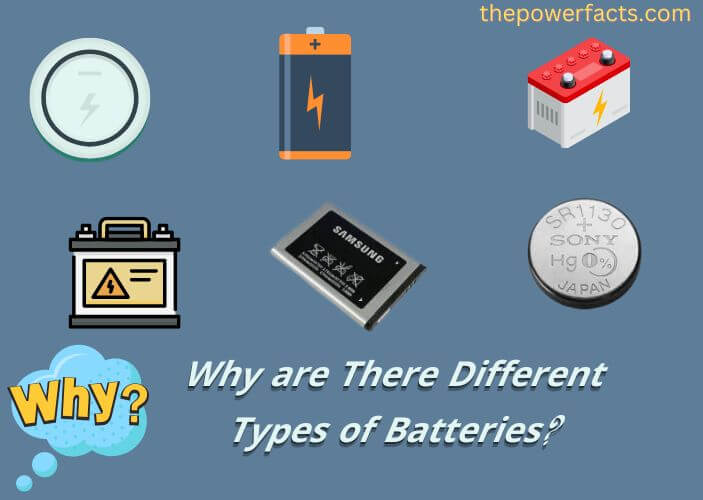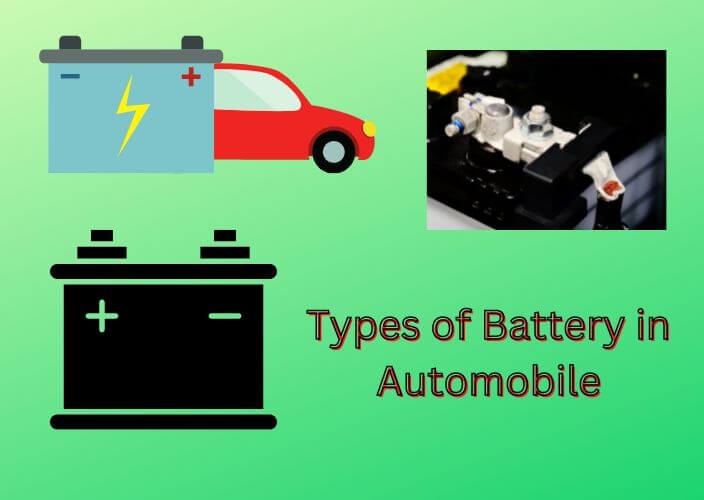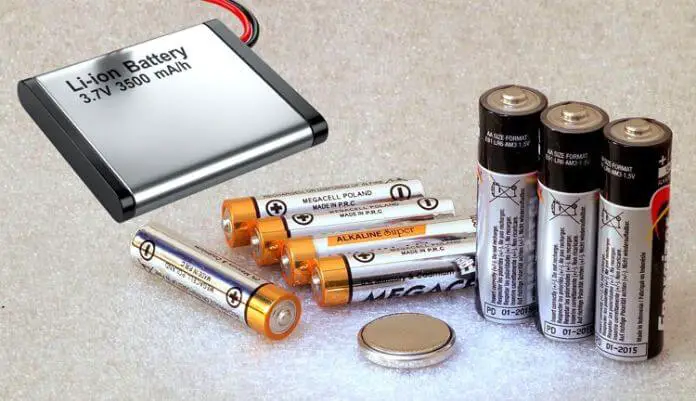Batteries are devices that store and release energy. They come in all shapes and sizes, from the small button batteries used in watches to the large batteries used in cars. There are many different types of batteries, each with its own advantages and disadvantages.

Some of the most common types of batteries include lithium ion, lead acid, nickel-cadmium, and nickel-metal hydride.
There are different types of batteries because they serve different purposes. The three most common types of batteries are alkaline (the first commercially successful alkaline batteries were invented in 1896 by French chemist Georges Leclanche), lead-acid, and lithium-ion. Alkaline batteries are the most common type of battery.
They’re inexpensive and have a long shelf life. Lead-acid batteries are used in cars and trucks. They’re more expensive than alkaline batteries, but they last longer and can handle more power demands.
Lithium-ion batteries are used in laptops, cell phones, and other portable electronic devices. They’re more expensive than other types of batteries, but they have a higher energy density, which means they can store more power in a smaller space.
Types of Battery
Batteries come in all shapes and sizes, and there are many different types to choose from. But with so many options on the market, it can be difficult to know which type of battery is best for your needs. Here, we’ll break down the most common types of batteries so you can make an informed decision about which one is right for you.
Lead-acid Batteries
Lead-acid batteries are some of the most common batteries used today. They’re often found in cars, trucks, and other vehicles because they’re durable and provide a lot of power. Lead-acid batteries work by using a chemical reaction between lead and sulfuric acid to create electricity.
Lithium-ion Batteries
Lithium-ion batteries are becoming increasingly popular due to their high energy density (the amount of energy that can be stored in a given space). Lithium-ion batteries work by using a lithium metal oxide cathode and a carbon anode. When these two materials are combined, they create an electrochemical reaction that produces electricity.
Nickel-cadmium (NiCd) Batteries
Nickel-cadmium (NiCd) batteries were once very popular but have now been mostly replaced by nickel-metal hydride (NiMH) batteries due to their lower cost and toxicity. NiCd batteries work by using a cadmium cathode and a nickel anode in an electrolyte solution. This creates an electric current when the two materials are connected together.
Nickel-metal Hydride (NiMH)
Nickel-metal hydride (NiMH) batteries are similar to NiCd batteries but use hydrogen instead of cadmium in their construction. This makes them less toxic than NiCd batteries while still providing good performance. NiMH battery cells usually contain between 1.2 volts and 1.6 volts of electrical potential.
Types of Batteries And Their Uses
There are many types of batteries, and each has its own advantages and disadvantages. The most common type of battery is the lead-acid battery, which is used in cars and trucks. Lead-acid batteries are very durable and can last for several years, but they are also heavy and can be difficult to dispose of properly.
Another common type of battery is the nickel-cadmium battery, which is used in many portable electronic devices. Nickel-cadmium batteries are light and easy to carry, but they can be expensive and have a limited life span. Lithium-ion batteries are becoming increasingly popular because they are lightweight and have a long life span.
However, lithium-ion batteries can be dangerous if they catch fire or leak chemicals into the environment.
There are different types of 9V batteries, each with its own advantages and disadvantages. Read the article for details.
Types of Battery in Automobile
There are many types of batteries in automobiles, and the type of battery you need depends on the make and model of your car. Some of the most common types of batteries used in cars are:
Lead-acid Batteries:
These are the most common type of automotive battery, and they’re typically found in older vehicles.
Lead-acid batteries have a short lifespan and aren’t very efficient, but they’re also relatively inexpensive.
Nickel-metal Hydride Batteries:
These batteries are more efficient than lead-acid batteries, but they’re also more expensive. Nickel-metal hydride batteries are typically found in newer vehicles.
Lithium-ion Batteries:
Lithium-ion batteries are the newest type of automotive battery, and they offer the best performance in terms of efficiency and lifespan. However, they’re also the most expensive type of battery available.

Types of Batteries in Electrochemistry
There are many different types of batteries in electrochemistry, and each has its own advantages and disadvantages. The most common types of batteries are lead-acid, nickel-cadmium, nickel-metal-hydride, and lithium-ion. Lead-acid batteries are the oldest type of battery and are still widely used today.
They are inexpensive and have a high energy density, but they are also heavy and can release harmful fumes if damaged. Nickel-cadmium batteries were once very popular, but have fallen out of favor due to their environmental impact. They are still used in some applications where their long life and low self-discharge make them advantageous.
Nickel-metal-hydride batteries are similar to nickel-cadmium batteries but do not contain cadmium so they are less harmful to the environment. These batteries also have a higher energy density than lead-acid batteries. Lithium-ion batteries are the newest type of battery technology and have many advantages over other types of batteries.
They have a very high energy density, they do not suffer from memory effects, and they can be recharged very quickly.
Types of Battery Cell
There are many different types of battery cells, each with its own advantages and disadvantages. The most common type of battery cell is the lead-acid cell, which is used in car batteries. Lead-acid cells are very durable and can withstand a lot of abuse, but they are also very heavy and contain poisonous chemicals.
Lithium-ion cells are much lighter than lead-acid cells and do not contain any poisonous chemicals, but they are also much more expensive. Lithium-ion batteries are often used in laptop computers and cell phones. Nickel-cadmium (NiCd) batteries were once very popular, but have fallen out of favor due to environmental concerns about cadmium.
Nickel-metal hydride (NiMH) batteries are similar to NiCd batteries but do not use cadmium, making them environmentally friendly. However, NiMH batteries tend to self-discharge quickly, making them less ideal for use in devices that need to be stored for long periods of time without being used.
Rechargeable Battery Types
There are many types of rechargeable batteries, each with its own advantages and disadvantages. But how many times can you charge a rechargeable battery before it needs to be replaced? The answer to this question depends on the type of battery and the quality of the charger. The most common types are lead-acid, nickel-cadmium, nickel-metal-hydride, and lithium-ion. Lead-acid batteries are the oldest type of rechargeable battery.
They are inexpensive and have a long life, but they are also heavy and can release harmful chemicals if not properly disposed of. Nickel-cadmium batteries were once the most popular type of rechargeable battery, but have fallen out of favor due to their toxicity. They are still used in some applications where weight is less important than reliability, such as in medical devices.
Nickel-metal-hydride batteries are similar to nickel-cadmium batteries, but do not contain cadmium and are therefore less toxic. They are commonly used in hybrid and electric vehicles. Lithium-ion batteries are the newest type of rechargeable battery.
They are lightweight and have a high energy density, making them ideal for portable electronics. However, they can be expensive and may pose a fire hazard if damaged or improperly used.
Types of Primary Batteries
There are many types of batteries, but primary batteries are the most common. There are three main types of primary batteries: alkaline, lithium, and lead acid. Alkaline batteries are the most common type of battery.
They are used in many devices, such as flashlights and radios. Lithium batteries are also common, and they are often used in cell phones and laptops. Lead acid batteries are not as common as the other two types, but they are still used in some devices, such as car batteries.

FAQs
What is the Difference between Different Types of Batteries?
There are many types of batteries available on the market, and the differences between them can be confusing. Here is a rundown of the most common types of batteries, their pros, and cons, and their best uses:
| Alkaline batteries | Alkaline batteries are the most common type of battery; they power everything from flashlights to remote controls. They are inexpensive and have a long shelf life, but they also have a relatively short lifespan once they are used. |
| Lithium-ion batteries | Lithium-ion batteries are more expensive than alkaline batteries, but they last longer and pack more power. They are often used in high-end electronics like laptops and digital cameras. |
| Nickel-cadmium (NiCd) batteries | NiCd batteries were once very popular, but have fallen out of favor due to their toxicity and tendency to leak acid when damaged. They are still used in some industrial applications |
| Nickel-metal hydride (NiMH) batteries | NiMH batteries are an improved version of NiCd batteries; they don’t leak acid and are less toxic. |
Why Do Batteries Come in Different Shapes And Sizes?
Batteries come in different shapes and sizes because they are designed to power a variety of devices. Some batteries are small and compact to fit easily into handheld electronics, while others are larger to provide more power for devices like laptops. The size and shape of a battery also determine how much energy it can store.
What are the 3 Types of Batteries?
There are three types of batteries: primary, secondary, and rechargeable. Each type has its own set of benefits and drawbacks.
Primary batteries are the most common type of battery.
They’re made from materials that can be easily found and are relatively inexpensive to produce. However, they can only be used once before they need to be disposed of. Additionally, primary batteries typically don’t last as long as other types of batteries.
Secondary batteries are made from more expensive materials and can be reused multiple times. They also tend to last longer than primary batteries. However, secondary batteries require special equipment for recycling, so they may not be the best option for those who are looking to reduce their environmental impact.
Rechargeable batteries are the most expensive type of battery, but they offer the longest lifespan and can be reused hundreds or even thousands of times. They’re also much more environmentally friendly than other types of batteries since there’s no need to keep buying new ones or disposing of old ones.
Why are Batteries Called AA And AAA?
The term “battery” refers to a device consisting of one or more electrochemical cells that convert chemical energy into electrical energy. The first known battery was invented in 1799 by Italian physicist Alessandro Volta, who called it the voltaic pile. The first car batteries were lead-acid batteries. They were invented in 1859 by French physicist Gaston Planté. Batteries come in a variety of shapes and sizes, but the most common are the AA and AAA varieties.
These batteries get their name from the International Electrotechnical Commission (IEC) standards that were established in 1947. The IEC set out guidelines for battery nomenclature, specifying that AA batteries must have a diameter of 14.5-14.8 mm and a length of 50.5-50.8 mm. AAA batteries, on the other hand, must have a diameter of 10.5-10.8 mm and a length of 44.5-44.8 mm.
Conclusion
Batteries come in all shapes and sizes, and each one is designed for a specific purpose. The three most common types of batteries are alkaline, lithium, and lead-acid.
Alkaline batteries are the most popular type of battery, thanks to their low cost and long shelf life.
They’re typically used in small devices like flashlights and remote controls. Lithium batteries are more expensive than alkaline batteries, but they offer a higher energy density, meaning they can power your devices for longer before needing to be replaced. Lead-acid batteries are the heaviest and bulkiest type of battery, but they’re also the cheapest option per watt of power they provide.
Lead-acid batteries are typically used in car starter motors and other applications where weight isn’t as much of a concern.